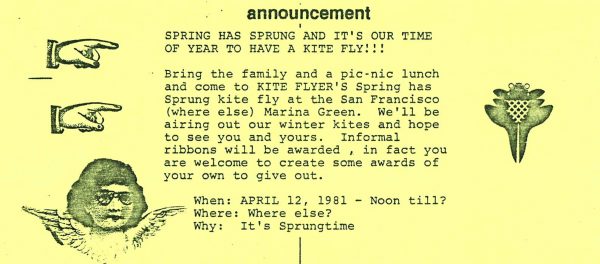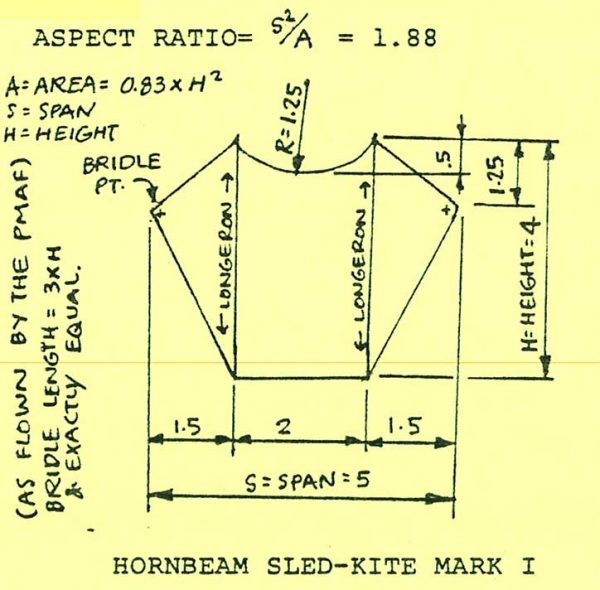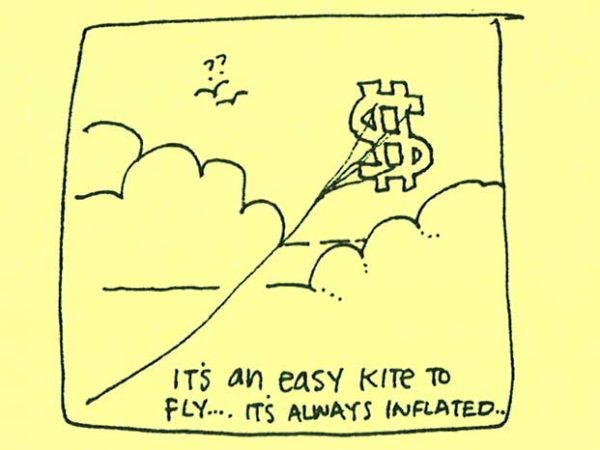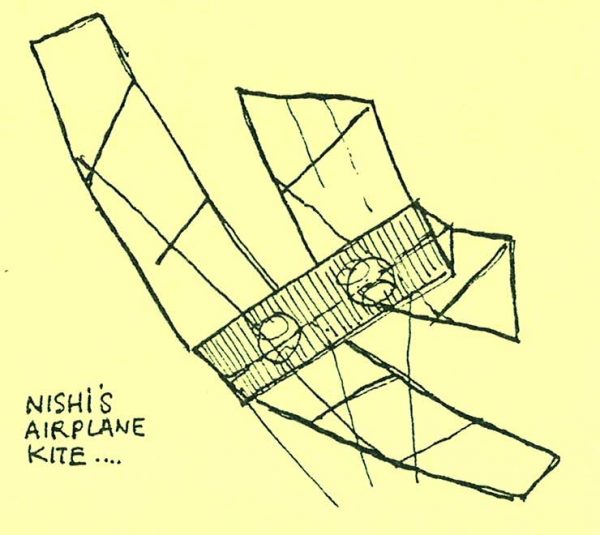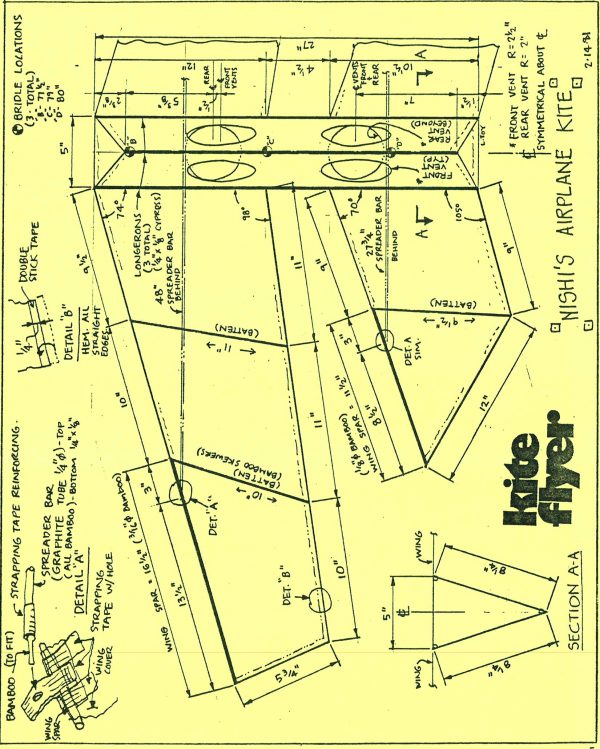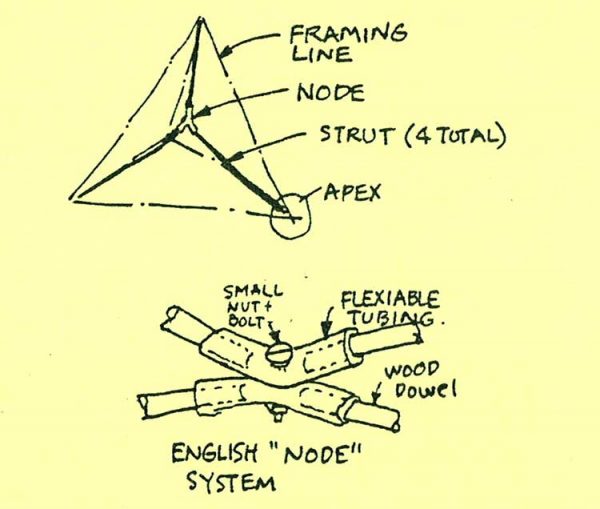By Lee Toy
Vol. 4 No.2 – Mar. – Apr. 1981
AKA UPDATE
AKA is alive a well with approx. 800 members. The new president is Beven Brown an active kiter from Mc Lean, Virginia. The AKA is still looking into an association management firm to help with the “office” work. Membership dues have been raised as of Feb. 1,1981 to $10.00/year. Two sites have been offered as possible convention locations for this year: Seattle and Houston. Red Braswell has donated a four drawer file, filled with archives, to the garage of Bob Price, AKA historian. Who knows next time we have an administration change we’ll have to hire moving vans, who were those guys that moved Jimmy’s ,
I heard they do a good job
ed. The following was brought to you by the January Minutes of the AKA.
YOU NEVER KNOW WHAT YOU’LL FIND
IN YOUR MAIL BOX
If the terms: Areodynamics, Magnus effect, Reynolds Numbers and Center of Drag. interest you then there is a DATA-LETTER being offered by the PMAF (Piney Mountain Air Force) that is just up your alley.
Several weeks ago I found a copy of Vol.1 no.2 in my mail box, what mail list I was on I don’t really know , but it was an interesting enough letter to find out more about who and what was behind it.
I sent in a subscription and an issue of KITE FLYER and got a great letter back from the Non-editor Guy D. Aydlett.
Dear Kite Flyer,
Thank you for the interesting copy of KITE FLYER and your subscription to PMAF DATA LETTER.
Discussions about C.G., C.P., Center of Drag, and other good things are planned for future issues of DATA-LETTER. We want to pursue some of these subjects; because we, too, have correspondents–too many of them–who take simplistic approaches and present simplistic conclusions about kite dynamics. Too many folk think in two-dimensional terms (if they think at all) about airflow over kites and other aircraft that have low Reynolds numbers.
The aspect ratio formula that you question is about as valid for a good sled as anyone is likely to come up with….
(ed. I had asked Guy about what the term: ASPECT RATIO means. I had always imagined it to deal with a wing’s length to width ratio. In the formula that Guy presented with regards to a Hornbeam Sled it is comparing the span squared divided by the area which I didn’t understand what the meaning of the results mean. The aspect ratio for the sled came out as follows:
HORNBEAM SLED-KITE MARK I
….It would be devilishly difficult to arbitrarily say that the curved canopy can be divided into absolute lift/non/lift areas. Tests we have made indicate that the lateral airflow over a sled canopy makes all of the area contribute someting in lift, something in drag, something in stability. (The sled looks simple to the eye, but it is a frightfully complicated aerodynamic entity; a quality it shares with just about everything that flys.) We have learned to shy away from absolute statements about kite performance. Too often, “experts” pop-off in print–fix hidebound conclusions forever in their books– and have to live with their follies.
Opinions from you correspondents tempt PMAF to point out– simp-listically– that one could build a perfectly circular kite that would have its C.G. precisely in its geometrical center of area (center of pressure when the kite is pre-sented normal to the wind); but if anyone can bridle it so that it flys well, we’d like to come and see it. C.P. is an elusive thing; don’t paint its position on a kite, because it usually changes its location as angle of attack changes, or when other conditions vary.
Kite aerodynamics are not simple. This fact is an important reason why the Piney Mountain Air Force came into existance.
Thank you for your good letter.
Aeolian blessings, Guy D. Aydlett,
Non-editor, PMAF
editor
In reference to Guy’s request for a perfectly circular kite, I am reminded of a kite that Nishibayashi had shown me on one of his last visits. It happened to be a perfect circle. It did not however have its C.G.(Center of Gravity) at its geometric center, had it been,I too, doubt that it would have been able to fly. Since this kite did fly, and fly well I must assume that the C.G. was not in the geometric center. The one thing that I mentioned in the last issue of Kite Flyer , in regards to the the C.G. and the C.P. was that if you were able to bridle a kite such that the C.P. and the C.G. aligned while at the same time maintaining a reasonable angle of attack that you would be most likley able to fly such a kite. This is a rather simplistic approach that is easily experimented with and easy to apply to flat kites with out tails. This is not to imply that these are the only factors involved with kite areodynamics, but rather an introduction that may serve to encourage others to begin thinking more about the dynamic forces involved in the actual kite flight. I encourage our readers to write in their thoughts on why they think their kites fly or don’t fly perhaps we can help each other learn more about these kiting aspects.
Kite Flyer encourages and hopes that the PMAF continues to publish a great Data-letter that anyone who is really interested in the more technical aspects of kiteing should subscribe to.
The PMAF DATA-LETTER is $7.50 per year or 75 per copy send check or money order to Guy D. Aydlett
POST OFFICE BOX 7304 , Charlottes-ville, VA 22906.
Tell him Kite Flyer sent you.
KITE OLYMPICS CANCELED,
It appears that Pier 39, a shopping complex in San Francisco has cancelled the Kite Olympics it had planned for May 30 & 31 of 1981.
They are planning to hold a smaller kite fly with demonstrations of some kite manufacturers and kite experts from the area. We’ll let you know more as soon as plans are finalized.
RAW FISH AND LOTS OF RICE
If you like raw fish and visiting with living cultural treasures, then perhaps you should consider Japan as you next vacation. Space is available for the 18 day journey to the East on Dave Checkley’s Kite Tour of Japan. Departure is in late April. For further information contact: Dave Checkley, P.O. Box9081 Seattle, Wa. 98109; (206)285-6262.
Several members of KITE FLYER have been fortunate and wealthy enough (before inflation) to have taken the plunge and would highly recommend this excellent way to meet some of the most warm and hospitable kite flyers from the land of the rising sun.
KITE OF THE MONTH
Nishibayashi, of Tokyo, Japan, seems to be spending more time stateside than in his native country. His last visit was during the AKA convention held in Seattle last October. At the kite fly there one of his airplane style kites placed 3rd for the most beautiful contest. This month’s kite design is a similar design to the winning kite. Although the kite is somewhat more complicated than some of his previous kites it is still basically a simple and straight-forward design. Typically his materials include bamboo, spruce and fiberglass/graphite spars with high-density polyethelyne for a cover material. The component parts are put together with double stick tape and strapping tape. The cover is colored with colored markers.
I first saw this kite while visiting Nishi in his home in Tokyo. I went to visit one afternoon with FrancosLe a student from France studying kite painting with professor Hiroi. We were greeted, or rather found by Nishi in the underground station of OGIKUBA which is about a twenty minute ride from downtown Tokyo.
We were invited to his home, a short walk from the station and met his okusan (wife) and one of his sons, who had prepared a delicious noodle dish for our lunch. After we looked thru those ever present photo albums we all have, we headed out to the flying field in his kite laden mini-station wagon.
When we arrived at the park I was surprized to see how small it was and at how many activities were happening. In the space of about one baseball diamond the following activities were going on: Frisbee tossing, soccer practice, martial arts exercises, bicycle riding, baby strolling and two ball games. To this we added three kite flyers to the two already there. I was ,amazed that all these things seemed to occur simultaneously with little conflicts. I believe it has some-thing to do with the Japanese sense of space. Life is much more crowded than we are used to in America and many activities are interwoven into a fabric of ordered chaos. It’s an experience.
There was very little wind but this did not deter Nishi from quickly lofting the airplane style kite (Kite of the Month) with deft man-nipulations of his reel. It left the other kiters envious as the kite rose well above the nearby tree tops and telephone wires surrounding the park.
Nishi then handed me his reel so that he could loft another kite. This time a fighter kite, which he wanted to show Franquois how to manuver, which she did, right into a tree (sounds just like Carol). Nishi would eventually bring this kite to the States to show it off at the convention. We are happy to be able to present it to our readers to add to their design collections.
MORE TETRA TIPS
How many framing struts are needed to frame a cell of a tetrahedron? If you guessed six, guess again. Next time try four if you do it from the inside of the structure, as Peter Lynn of New Zeland did in his Tetra kite he brought to the AKA convention.
Evidently the internally braced structure had also been developed in England, as a kite from there also has internal braces. In talking with Pete, he says that he developed his method of framing independently from that of the English conter-part.
The bracing consists of four struts connected to a “NODE” in the center of the tetrahedron, with the framing lines providing the necessary tension to give the structure shape. In the English version, flexiable tubing was used for the node with wood dowels for the struts.
Peter’s kite cell was quite a bit larger and he used small diameter aluminum tubing for his struts with a metal clip device for the Node connections. Peter also increased the angles to provide more lifting surfaces to each cell.
By using either method, one should theoretically be able to reduce the weight of the framing of a tetrahedron cell by 30%.
Things to keep in mind with this technique of framing:
A) Use stiff struts members
B) Framing lines must be taut
I don’t recall the connection at the Apexs but think that the framing lines could pass over notches in the apex ends of the struts. Also, the cell to cell connections were not totally developed by Peter at this time. He was using bailing wire to t e the cells and assured me that there was a better way.
By way of standard reference–KITE FLYER NEWS is available six times a year (weather permitting) at the minimal cost of a trip to Doggie Diner–$5.00 a shot. Send all money, trading stamps or gold bars to 861 Clara Drive, Palo Alto, CA 94303.



